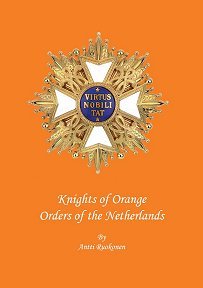Knights of Orange: Orders of the Netherlands
by Antti Ruokonen

In the Introduction, the author speaks of his long fascination with the Orders of Europe and how it has led him to study and write about them (this is his fourth book), and about how the study of Orders is inextricably wrapped up in the history of the nation which awarded them. He has enjoyed good relations with official Dutch sources which shows in the detail of information and many of the images throughout the book, as well as a forword from the Het Loo National Museum.
The book itself begins with a page that shows the order of precedence of Dutch orders as it has changed over the years, mostly due to the addition of new orders from time to time. It then launches into a brief history of the Netherlands, which makes for fascinating reading and shows the pivotal role played by this nation in the development of modern Europe. Following a photograph of the current King, detailed biographies of two former monarchs - the first sovereign William I and Queen Wilhemina who ruled during the turbulent times of both World Wars.
Next comes a brief general discussion of how the Netherlands manages her orders, the process by which they are awarded and so on, before a detailed analysis of the premier order, the Military Order of William, which was instituted in 1815, two hundred years ago almost to the day of this review (it was established on 30 April 1815)! Although founded by King William I, it was not named for himself but for the first Prince of Orange (752-812 A.D.). It is particularly fascinating in that the fourth class of the order, or Knight 4th Class, is awarded for courage in the face of the enemy in a manner equivalent to the British Victoria Cross, whilst higher grades are awarded to senior officers for meritorious service.
Discussion of the design and award of the order is followed by detailed photographs of the insignia showing variations of grade and through time, obverse and reverse, along with diplomas, cases, and the current design. Medal bars, miniatures and portraits of some notable recipients round out this section. Coupled with this order is the Sabre of Honour, presented for repeated acts of bravery - some say to prevent junior service personnel from holding a higher class of the order than their superiors!
Following chapters give similar treatment to the Order of the Netherlands Lion, the Order of Orange-Nassau, and the Order of the Gold Lion of the House of Nassau - an order with a complex history as it was instituted jointly by the King-Grand Duke of the Netherlands and Luxembourg William III and Duke Adolf of Nassau in 1858 originally in a single class. Later William III added extra classes, somthing that Adolf never agreed with and so abolished when he succeeded to the Grand-Ducal throne in 1892. Since then the order has been awarded in a single class to this day.
This is followed by the even more complex House Order of Orange, which was instituted in 1905 but reorganised in 1969 into a bewildering array of awards - the Order of the House, the Order of the Crown, the Order of Loyalty and Merit, and a whole series of Medals of Honor for the Arts and Sciences and for initiative and ingenuity. Ruokonen picks his way through this complexity and makes all plain, however, with charts as well as illustrative pictures of the insignia.
The final order discussed is the Order of the Golden Ark, which isn't a regular order at all but a personal award established by Prince Bernhard of the Netherlands in 1971 to mark achievement in the area of nature conservation, his particular passion. It has not been awarded since Prince Bernhard died in 2004, and its future is as yet unknown.
Notes on two famous recipients of Dutch orders - Dwight Eisenhower (President of the United States) and Martti Ahtisaari (President of Finland) - a word to collectors, notes on hallmarks and other details round the work off.
With a wealth of glorious illustrations and detailed systematic text, this book is a feast for eye and mind, and well worth the getting if you delight in orders of knighthood.
Get yours here:
- Finnmedals - http://www.finnmedals.com/
- Orden de Welt - http://cms.orden-der-welt.de/index.php/en/
- Bonus Eventus - http://www.bonus-eventus.be/
- Amazon.com - http://www.amazon.com/
- Amazon.co.uk - http://www.amazon.co.uk/
Page last updated: 3 May 2015